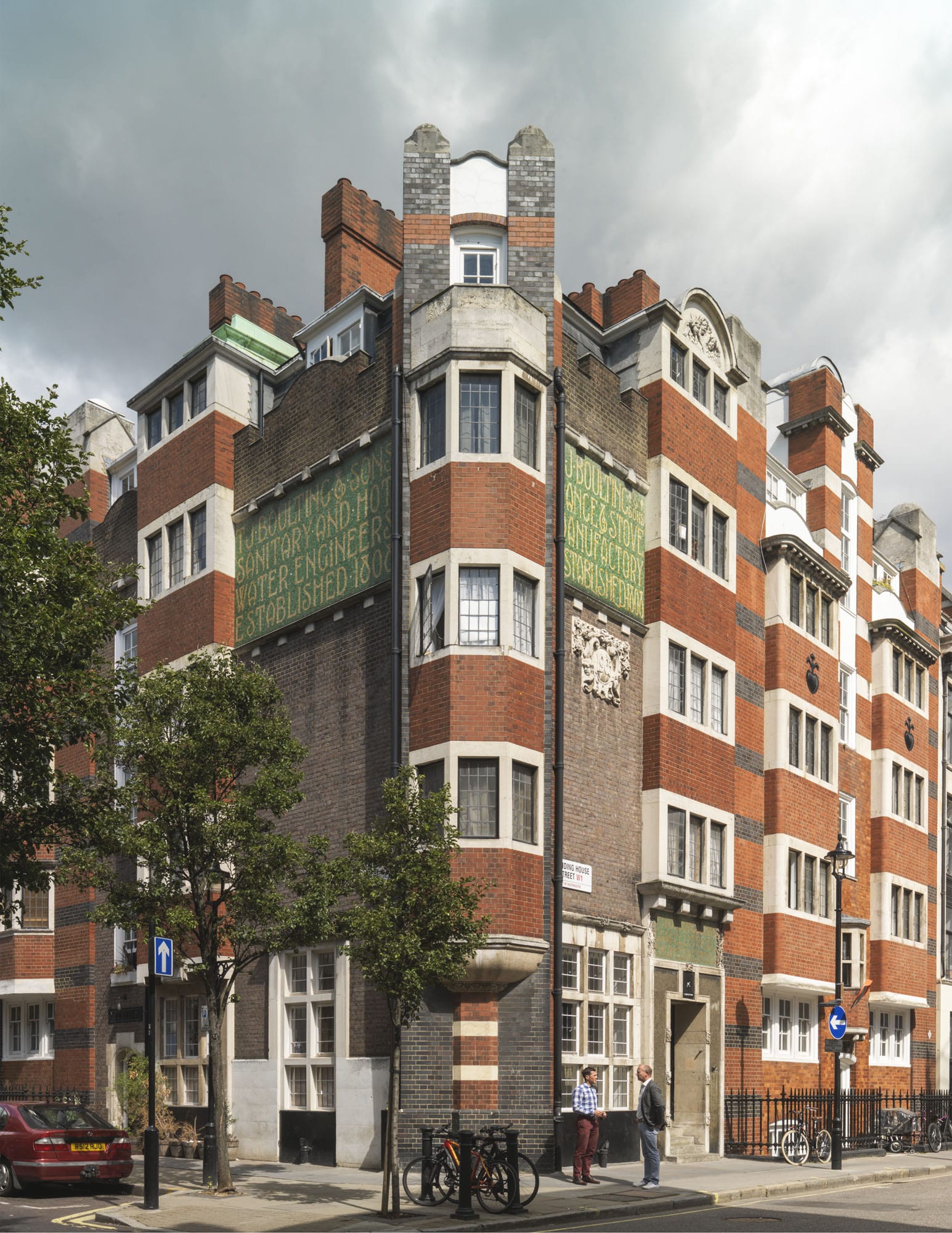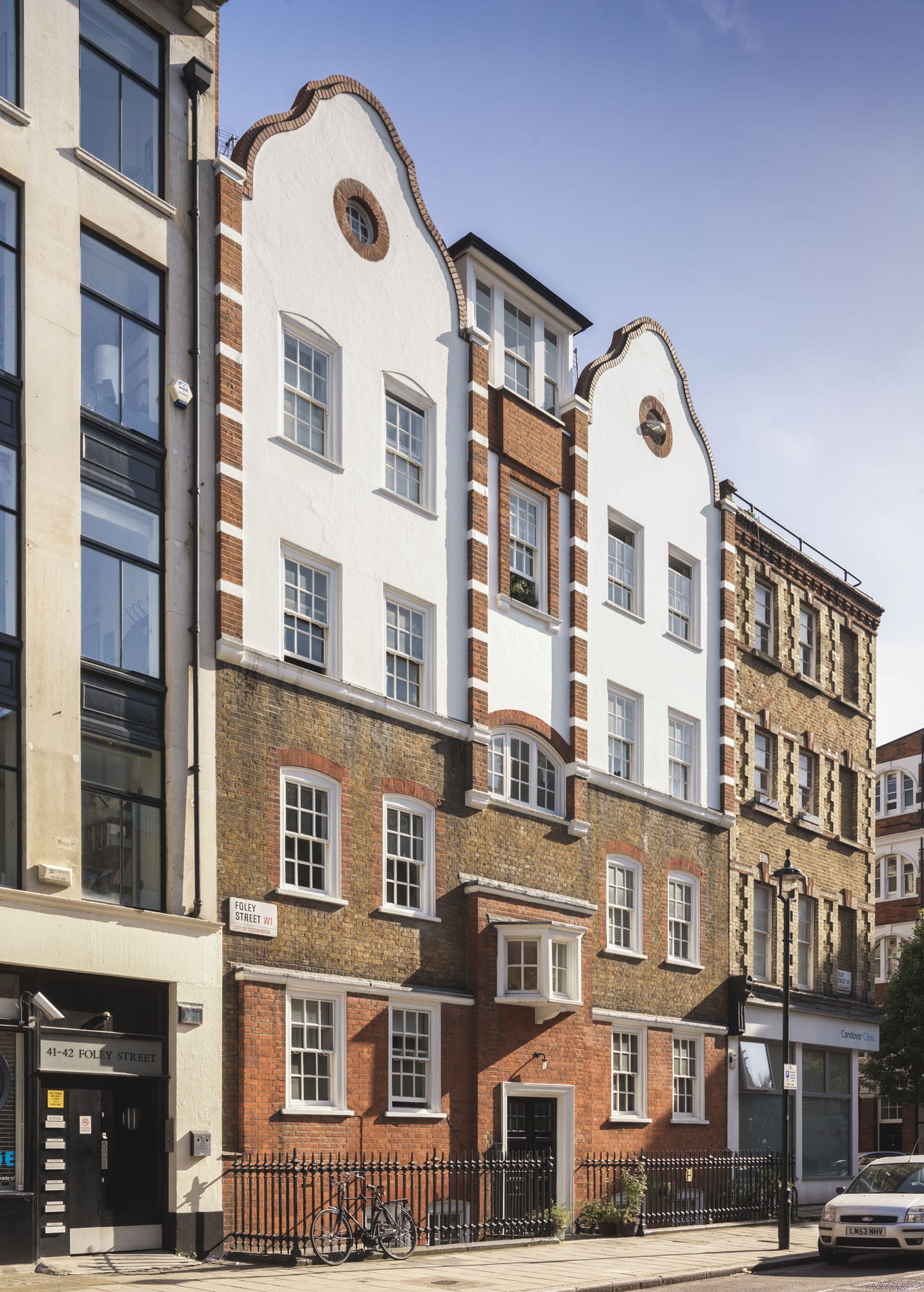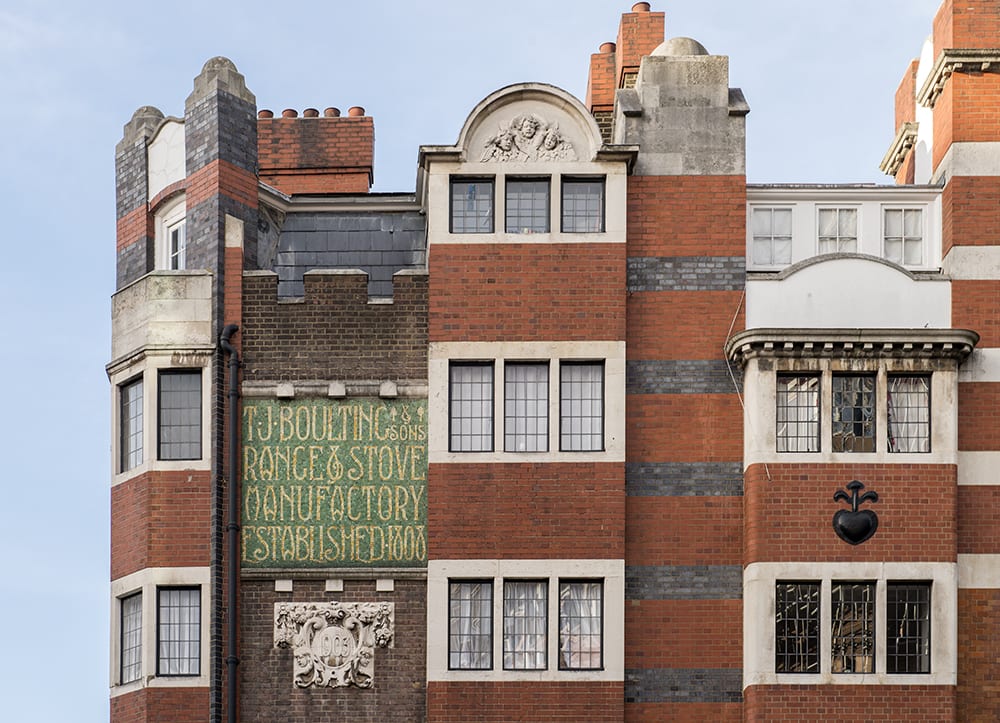Boulting & Sons
By the Survey of London, on 19 May 2017
At the corner of Riding House Street and Candover Street stands one of South East Marylebone’s architectural gems: a group of flats designed for T. J. Boulting & Sons. John Boulting & Son, furnishing ironmongers, were established perhaps as early as 1808 in two nearby houses. This is the date that is proudly displayed on the building, picked out in gold mosaic tiles along with the company name.

Detail of 59-61 Riding House Street, Marylebone, Greater London. View from south. Taken for the Survey of London by Chris Redgrave © Historic England
Successive John Boultings died in 1863 and 1873, and a partnership dissolution between a third John and Thomas John Boulting was announced in 1879. Thereafter the firm was known as T. J. Boulting (& Sons).

59-61 Riding House Street, Marylebone, Greater London. View from south west. Taken for the Survey of London by Chris Redgrave © Historic England
Among these sons was Percy Boulting, born about 1876 and seemingly architect-trained, to whose youthful aspirations the present buildings may well have been due. The firm had done well enough for members of the family, at first the father and then Percy’s brothers, to branch out into small property dealings on the Howard de Walden estate from the late 1890s. Naturally they took a special interest in rebuilding around their works. Their first venture appears to have been 40 Foley Street, a five-storey block of flats directly behind the Boultings’ address, built by John Anley in 1898. Its designers were then described as Clark & Hutchinson with Percy A. Boulting, in other words H. Fuller Clark and C. E. Hutchinson, two architects aged about 28 who had met in the office of Rowland Plumbe, plus the even younger Boulting. Later No. 40 was ascribed to Clark alone, and it is to him that the flamboyance of the Boultings’ cluster is usually credited. Clark’s masterpiece is the recasting of the Black Friar pub in the City; otherwise his work is little known, though he claimed to have a substantial practice.

Flats built for Boultings at 40 Foley Street, designed by H. Fuller Clark, perhaps with H. E. Hutchinson and Percy A. Boulting. Taken for the Survey of London by Chris Redgrave © Historic England
Architecturally, No. 40 is an up-to-date but not eccentric performance which breaks into roughcast at second-floor level and terminates in two shaped gables. The plan follows the standard late Victorian arrangement in this quarter of two flats per floor, originally with a sanitary excrescence at the back in the form of a central stack of bays shared between two flats. Clark & Hutchinson promptly followed up in 1899 with a second block of flats opposite, Belmont House, 5–6 Candover Street, built this time by A. A. Webber. Here a similar plan is fronted in a weightier, fussier idiom, with a great belt of purple brickwork enveloping the first floor and a dab of Art Nouveau lettering.

Tower House, Candover Street. H. Fuller Clark and Percy Boulting, 1903-4. Taken for the Survey of London by Chris Redgrave © Historic England
Tower House, York House and Oakley House, encompassing the Boultings’ former premises and the Sir Isaac Newton pub on the corner, followed on in 1903–4. This time the architects were described as Fuller Clark and Percy Boulting, without Hutchinson: the builders were Smith & Co. of Mount Street. Again these are essentially five-storey flats, though the backs go one storey higher; here too were originally bare sanitary stacks of bay windows. The fronts are the reverse of bare. Among the tricks set to work are brickwork bands of startling hues, bay projections both canted and square, a bristling roofline and three separate fancily lettered mosaic panels advertising the Boultings firm and its wares (‘gas and electrical engineers’; ‘sanitary and hot water engineers’; ‘appliance and stove manufactory’).

Detail of 59-61 Riding House Street, Marylebone, Greater London. View from south. Taken for the Survey of London by Chris Redgrave. © Historic England
Colour was an evident preoccupation; originally three different cements were used, while the window joinery was all white apart from the bay windows, finished in stained oak. Despite the hint of Voysey about these elevations, they are entirely individual and indeed this building too was attributed to Clark alone when it was republished. The Boultings firm survived at 59 Riding House Street up until the 1960s. In 1978 the freehold of all their flats passed to the Community Housing Association, which employed Pollard, Thomas & Edwards, architects, to update them over the subsequent decade. Their changes included enlarging the sanitary bays at the back to form more generous kitchens.

Detail of 59-61 Riding House Street, Marylebone, Greater London. View from south. Taken for the Survey of London, by Lucy Millsom-Watkins © Historic England
7 Responses to “Boulting & Sons”
- 1
- 2
-
3
Ruth Richardson wrote on 24 May 2017:
I have always loved this cluster of related buildings, and remember discovering them in the 1960 to my utter joy. They form a splendid corner of London, and to find that there’s an association with the Black Friar pub, another site of joyous architectural pleasure (I remember it from long ago with formica tables and dirty ashtrays, unkempt but glowingly beautiful nevertheless) is a delight. THANK-YOU so much for writing/researching this piece.
-
4
Ruth Richardson wrote on 24 May 2017:
I have always loved this cluster of related buildings, and remember discovering them in the 1960s to my utter joy. They form a splendid corner of London, and to find that there’s an association with the Black Friar pub, another site of joyous architectural pleasure (I remember it from long ago with formica tables and dirty ashtrays, unkempt but glowingly beautiful nevertheless) is a delight. Of course, NOW I chastise myself for not going in to seek the archives of that interesting company, which from the dates you mention seems to have still been going when I first fell in love with their building. I regret that I was too young to think of that then.
THANK-YOU so much for writing/researching this piece. -
5
Peter barber wrote on 13 October 2019:
This is fascinating…. always loved these buildings
Always love the blackfriar . Had seen it attributed to h fuller clark in a book on art nouveau architecture in the early 80’s…but could find nothing out about him at the time and now I tumble in this connection . WOW someone should do more research On Him I suspect there are other gems …. THANKU THSNKU THANKU !
-
6
Paul Hammond wrote on 9 April 2021:
“Discovered” this wonderful building during an exploration of Fitzrovia. Some Mackintosh vibes going on here……
-
7
Tina ion-brown wrote on 27 November 2022:
I live in 40,Foley street and I’m wondering why this area is called Marylebone and not Fitrovia.
Can anyone explain please?
 Close
Close



They were always a delight, hinting at a noble purpose, honest manufacture, not just office work.